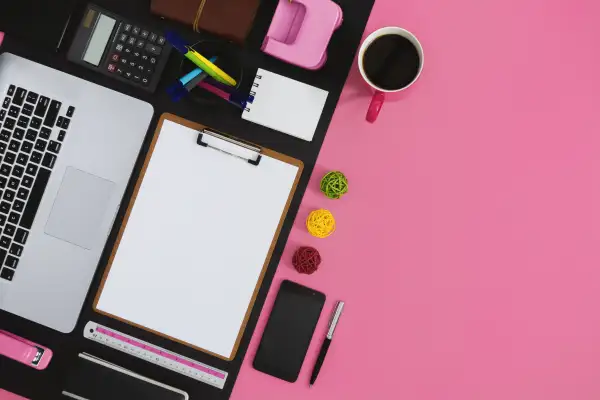The Best Ways to Organize Your Desk at Work, According to Experts

If your work schedule hits a lull between Christmas and New Year’s, experts have lots of ideas about how to use that time productively.
One of the most effective uses for holiday-season work down time is to get a handle on organizing your workspace and clearing it of clutter. We tapped professional organizers to find out their best strategies and product recommendations so that you — and your workspace — can start off 2020 with a literal and figurative clean slate.
Watch out for Clutter-Creep
“I often see clutter accumulation on desktop surfaces, file trays which turn into piles, over-pinned bulletin boards, bulging bookshelves, etc.,” says Jennifer Truesdale, owner of STR8N Up Professional Organizing Services in the greater Charleston, S.C. area. “Many times the user slowly adds things to the areas and then ends up having a blind eye to it because it was a gradual process to get cluttered.” If you have a system to keep junk from building up in the first place, you won’t find yourself trying to tackle a huge mess.
Give Everything Its Own Place
“Assign a home for everything. It’s much easier to put something away when you have a specific place for it,” says Susie Hayman, owner of In Your Business Professional Organizing Services in the greater Richmond, Va. area, and president of the National Association of Productivity and Organizing Professionals. This includes, she adds, stuff you don’t really know what to do with or that you need to review later.
Don’t Assume the Best Desk Is a Bare Desk
While Marie Kondo-style minimalism might work best for some people, it’s not the only answer to a tidy workspace. “Someone who is a very visual processor would not do well if everything was put away out of sight,” Truesdale says. If you fit this description, she advises using a color-coded filing system so you can keep track of your work at a glance.
The Trick to Tackling Files: Divide and Conquer
The trick to creating a truly useful filing system is to create broad categories, then subdivide those into more specific categories, Hayman says. “Use hanging files for the categories and file folders for sub-categories,” she says. “Keep your file tabs justified to the left or right; don’t stagger them. Develop a color coding system,” she advises — and alphabetize everything.
For More Space, Think Vertically
“I find using desktop vertical filers on the desk to be the best for keeping current working files organized and reachable,” Truesdale says. “In piles, things tend to get lost, but when tabbed vertically, your eyes are drawn to the labels.” Horizontal piles, she adds, also take up more space and can spill over more easily and encroach into other areas.
Put an Expiration Date on Your Paperwork
With the new year on the horizon, Hayman offers some timely advice about what to toss. “If you haven’t referred to it in a year or it’s outdated, it probably doesn’t need to be in your active files or in your office,” she says.
The Right Tools For the Job
Hayman and Truesdale recommend the following organizing tools and supplies as the building blocks of a well-organized workspace:
• Unless you have an all-digital job, Hayman says a desktop file box with folders is indispensable for keeping tasks organized. “This should include action items, projects and routine to do’s,” she says.
• Invest in drawer organizers, Truesdale advises. They’ll help keep your items sorted by category, so you won’t waste time hunting through a jumble of stuff. “Find what you need quickly without rummaging,” she says.
• Hayman says if you use a paper planner or calendar, a desktop one is the best bet. She suggests Planner Pad, Bullet Journal, Full Focus Planner or the Staples ARC system.
• Even if you've replaced paper with electronic files, Hayman says telling time the old-fashioned way has its merits. “An analog clock helps with time management, because you can actually ‘see’ the time pass,” she says.
• Finally, Truesdale says she also swears by the following supplies for keeping a workspace tidy: Clear pocket folders, rubber bands, paper clips, sticky notes and file folders.
We’ve included affiliate links into this article. Click here to learn what those are.
